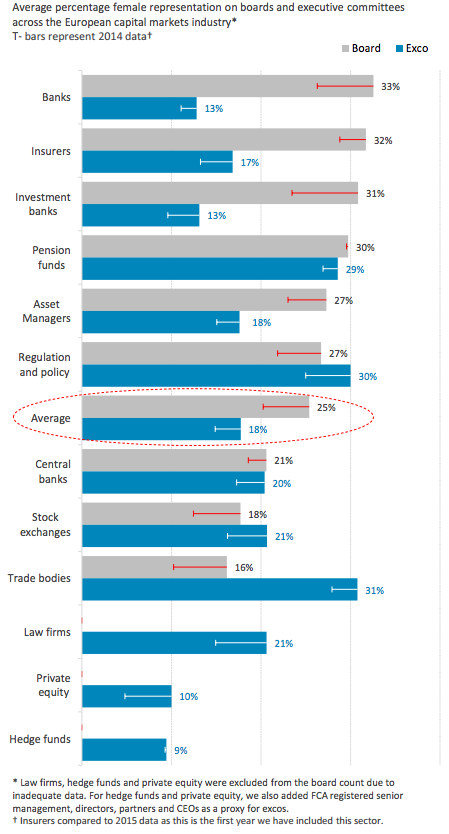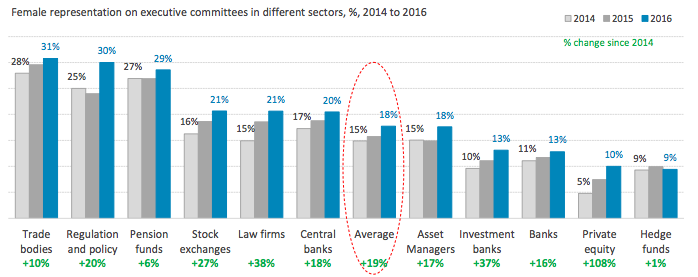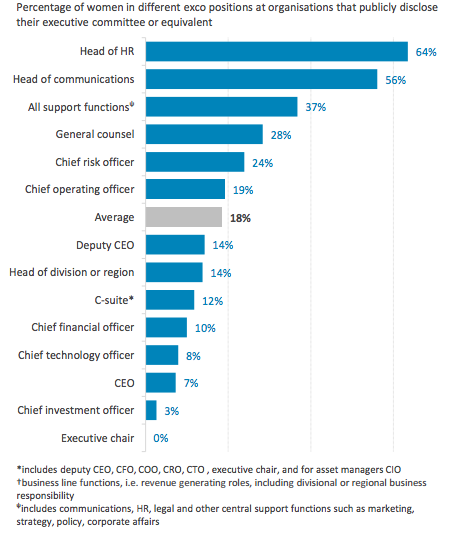Whether the old boys in the industry are prepared for it or not, change is swiftly underway across financial institutions in Europe. The business case for diversity is clear, and in the UK, the impetus for boosting gender parity in financial services has received strong support from both the public and private sector. From initiatives like HM Treasury’s Women in Finance Charter to the Women in Finance Awards slated for later this month, there is a lot of momentum and pressure on institutions and businesses to encourage career advancement for women in the sector, traditionally trapped in middle management and overlooked for promotions.
A report released today by think tank New Financial shows that gender diversity is improving across European capital markets, but beneath the thin veneer of overall progress, it also reveals discrepancies within the sector and job roles. The report, Counting Every Woman 2017, measures female representation on boards and executive committees of 240 companies and institutions and finds that female representation has increased across all 12 sectors on both boards and executive committees.

In the asset management industry, the percentage of women on boards has increased to 27 per cent, up from 23 per cent three years ago. On executive committees, female representation has increased to 18 per cent, from 15 per cent in 2014. These averages are not far off the FTSE100, where 27 per cent of board positions and 19 per cent of executive committee roles are held by women.
The firm closest to real gender parity in the asset management sector is Columbia Threadneedle, a finalist for Employer of the Year in the Women in Finance Awards.
Women comprise 40 per cent of the firm’s executive committees and 33 per cent of the board. “I hope this positive momentum will help change the perception of the City, to one that offers a viable and fulfilling career destination for women. We need to attract more women into financial services and support mid-career women to ensure a healthy leadership pipeline,” Alison Jefferis, head of corporate affairs, EMEA at Columbia Threadneedle said.
In 2015, Columbia Threadneedle Investments became the first asset manager to voluntarily disclose its gender diversity data, in response to the lack of disclosure among European asset managers. In March 2016, Columbia Threadneedle was one of seven founding signatories and the first asset manager to sign the Women in Finance Charter.
While the upward trajectory is worth celebrating, these figures are still far from a fair 50-50 gender split.
Average female representation on boards at banks, for example, stands at 33 per cent, more than double the number on executive committees at 13 per cent.

While these statistics sound like good progress is being made, it’s an average figure that hides discrepancies across different functions. For example, average female representation on executive companies is lowest at 9 per cent for hedge funds, 10 per cent for private equity, rising to 30 per cent for regulators and 31 per cent for trade bodies.

When it comes to the types of roles women hold on boards and executive committees, the research highlights a dearth of women in frontline business roles. The 25 per cent average female representation on boards masks the fact that the proportion of female non-executive directors (26 per cent) is more than twice that of executive directors (12 per cent).
On executive committees, most women tend to be in support roles rather than in the C-suite or revenue-generating functions. Women account for 37 per cent of support roles on these committees, such as heads of human resources (64 per cent) and heads of communications (56 per cent). However, women only make up 14 per cent of heads of division, 12 per cent of the C-suite, and 7 per cent of CEOs.
The report recommends a few ways to bridge this hidden gap. One method is to promote female leaders in functions that are essential to the executive committee. This sends a strong message of intent to the rest of the committee and the wider organisation. Companies can also play an active role in encouraging women to pursue business-leading positions by mentoring and guiding them early on in their careers, as well as widening their criteria of the skills they want in a board or executive committee member beyond a the perceived requirements or skills formed by men who occupied these roles for decades.







